<Back to Index>
- Mathematician David Hilbert, 1862
- Mathematician Hermann Minkowski, 1864
PAGE SPONSOR
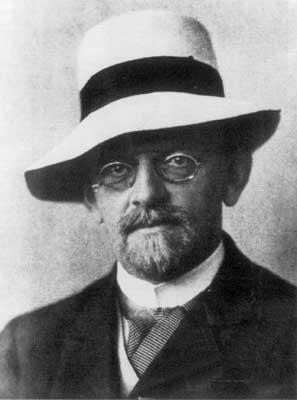
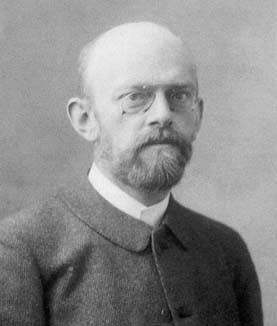
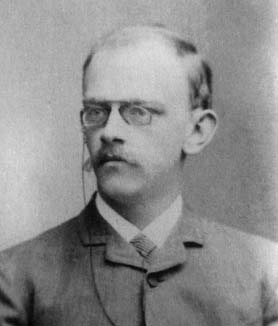
David Hilbert, FRS (January 23, 1862 – February 14, 1943) was a German mathematician. He is recognized as one of the most influential and universal mathematicians of the 19th and early 20th centuries. Hilbert discovered and developed a broad range of fundamental ideas in many areas, including invariant theory and the axiomatization of geometry. He also formulated the theory of Hilbert spaces, one of the foundations of functional analysis.
Hilbert adopted and warmly defended Georg Cantor's set theory and transfinite numbers. A famous example of his leadership in mathematics is his 1900 presentation of a collection of problems that set the course for much of the mathematical research of the 20th century.
Hilbert and his students contributed significantly to establishing
rigor and developed important tools used in modern mathematical physics.
Hilbert is known as one of the founders of proof theory and
mathematical logic, as well as for being among the first to distinguish
between mathematics and metamathematics.
Hilbert, the first of two children of Otto and Maria Therese (Erdtmann) Hilbert, was born in the Province of Prussia - either in Königsberg (according to Hilbert's own statement) or in Wehlau (known since 1946 as Znamensk) near Königsberg where his father worked at the time of his birth. In the fall of 1872, he entered the Friedrichskolleg Gymnasium (Collegium fridericianum, the same school that Immanuel Kant had attended 140 years before), but after an unhappy duration he transferred (fall 1879) to and graduated from (spring 1880) the more science oriented Wilhelm Gymnasium. Upon graduation he enrolled (autumn 1880) at the University of Königsberg, the "Albertina". In the spring of 1882, Hermann Minkowski (two years younger than Hilbert and also a native of Königsberg but so talented he had graduated early from his gymnasium and gone to Berlin for three semesters), returned to Königsberg and entered the university. "Hilbert knew his luck when he saw it. In spite of his father's disapproval, he soon became friends with the shy, gifted Minkowski." In 1884, Adolf Hurwitz arrived from Göttingen as an Extraordinarius, i.e., an associate professor. An intense and fruitful scientific exchange between the three began and especially Minkowski and Hilbert would exercise a reciprocal influence over each other at various times in their scientific careers. Hilbert obtained his doctorate in 1885, with a dissertation, written under Ferdinand von Lindemann, titled Über invariante Eigenschaften spezieller binärer Formen, insbesondere der Kugelfunktionen ("On the invariant properties of special binary forms, in particular the spherical harmonic functions").
Hilbert remained at the University of Königsberg as a professor from 1886 to 1895. In 1892, Hilbert married Käthe Jerosch (1864 – 1945), "the daughter of a Konigsberg merchant, an outspoken young lady with an independence of mind that matched his own". While at Königsberg they had their one child Franz Hilbert (1893 – 1969). In 1895, as a result of intervention on his behalf by Felix Klein he obtained the position of Chairman of Mathematics at the University of Göttingen, at that time the best research center for mathematics in the world and where he remained for the rest of his life.
His son Franz would suffer his entire life from an (undiagnosed)
mental illness, his inferior intellect a terrible disappointment to his
father and this tragedy a matter of distress to the mathematicians and
students at Göttingen. Sadly, Minkowski — Hilbert's "best and truest friend" — would die prematurely of a ruptured appendix in 1909.
Among the students of Hilbert were: Hermann Weyl, chess champion Emanuel Lasker, Ernst Zermelo, and Carl Gustav Hempel. John von Neumann was his assistant. At the University of Göttingen, Hilbert was surrounded by a social circle of some of the most important mathematicians of the 20th century, such as Emmy Noether and Alonzo Church.
Among his 69 Ph.D. students in Göttingen were many who later became famous mathematicians, including (with date of thesis): Otto Blumenthal (1898), Felix Bernstein (1901), Hermann Weyl (1908), Richard Courant (1910), Erich Hecke (1910), Hugo Steinhaus (1911), and Wilhelm Ackermann (1925). Between 1902 and 1939 Hilbert was editor of the Mathematische Annalen, the leading mathematical journal of the time.
"Good, he did not have enough imagination to become a mathematician".—Hilbert's response upon hearing that one of his students had dropped out to study poetry.
Hilbert lived to see the Nazis purge many of the prominent faculty members at University of Göttingen in 1933. Those forced out included Hermann Weyl (who had taken Hilbert's chair when he retired in 1930), Emmy Noether and Edmund Landau. One who had to leave Germany, Paul Bernays, had collaborated with Hilbert in mathematical logic, and co-authored with him the important book Grundlagen der Mathematik (which eventually appeared in two volumes, in 1934 and 1939). This was a sequel to the Hilbert - Ackermann book Principles of Mathematical Logic from 1928.
About a year later, Hilbert attended a banquet and was seated next to the new Minister of Education, Bernhard Rust.
Rust asked, "How is mathematics in Göttingen now that it has been freed
of the Jewish influence?" Hilbert replied, "Mathematics in Göttingen?
There is really none any more."
By the time Hilbert died in 1943, the Nazis had nearly completely restaffed the university, inasmuch as many of the former faculty had either been Jewish or married to Jews. Hilbert's funeral was attended by fewer than a dozen people, only two of whom were fellow academics, among them Arnold Sommerfeld, a theoretical physicist and also a native of Königsberg. News of his death only became known to the wider world six months after he had died.
The epitaph on his tombstone in Göttingen is the famous lines he had spoken at the conclusion of his retirement address to the Society of German Scientists and Physicians in the fall of 1930:
- Wir müssen wissen.
- Wir werden wissen.
In English:
- We must know.
- We will know.
The day before Hilbert pronounced these phrases at the 1930 annual
meeting of the Society of German Scientists and Physicians, Kurt Gödel —
in
a roundtable discussion during the Conference on Epistemology held
jointly with the Society meetings — tentatively announced the first
expression of his incompleteness theorem.
Hilbert's first work on invariant functions led him to the demonstration in 1888 of his famous finiteness theorem. Twenty years earlier, Paul Gordan had demonstrated the theorem of the finiteness of generators for binary forms using a complex computational approach. Attempts to generalize his method to functions with more than two variables failed because of the enormous difficulty of the calculations involved. In order to solve what had become known in some circles as Gordan's Problem, Hilbert realized that it was necessary to take a completely different path. As a result, he demonstrated Hilbert's basis theorem: showing the existence of a finite set of generators, for the invariants of quantics in any number of variables, but in an abstract form. That is, while demonstrating the existence of such a set, it was not a constructive proof — it did not display "an object" — but rather, it was an existence proof and relied on use of the Law of Excluded Middle in an infinite extension.
Hilbert sent his results to the Mathematische Annalen. Gordan, the house expert on the theory of invariants for the Mathematische Annalen, was not able to appreciate the revolutionary nature of Hilbert's theorem and rejected the article, criticizing the exposition because it was insufficiently comprehensive. His comment was:
- Das ist nicht Mathematik. Das ist Theologie.
- (This is not Mathematics. This is Theology.)
Klein, on the other hand, recognized the importance of the work, and guaranteed that it would be published without any alterations. Encouraged by Klein and by the comments of Gordan, Hilbert in a second article extended his method, providing estimations on the maximum degree of the minimum set of generators, and he sent it once more to the Annalen. After having read the manuscript, Klein wrote to him, saying:
- Without doubt this is the most important work on general algebra that the Annalen has ever published.
Later, after the usefulness of Hilbert's method was universally recognized, Gordan himself would say:
- I have convinced myself that even theology has its merits.
For all his successes, the nature of his proof stirred up more trouble than Hilbert could have imagined at the time. Although Kronecker had conceded, Hilbert would later respond to others' similar criticisms that "many different constructions are subsumed under one fundamental idea" — in other words (to quote Reid): "Through a proof of existence, Hilbert had been able to obtain a construction"; "the proof" (i.e., the symbols on the page) was "the object". Not all were convinced. While Kronecker would die soon after, his constructivist philosophy would continue with the young Brouwer and his developing intuitionist "school", much to Hilbert's torment in his later years. Indeed Hilbert would lose his "gifted pupil" Weyl to intuitionism — "Hilbert was disturbed by his former student's fascination with the ideas of Brouwer, which aroused in Hilbert the memory of Kronecker". Brouwer the intuitionist in particular opposed the use of the Law of Excluded Middle over infinite sets (as Hilbert had used it). Hilbert would respond:
- Taking the Principle of the Excluded Middle from the mathematician ... is the same as ... prohibiting the boxer the use of his fists.
The text Grundlagen der Geometrie (tr.: Foundations of Geometry) published by Hilbert in 1899 proposes a formal set, the Hilbert's axioms, substituting the traditional axioms of Euclid. They avoid weaknesses identified in those of Euclid, whose works at the time were still used textbook - fashion. Independently and contemporaneously, a 19 year old American student named Robert Lee Moore published an equivalent set of axioms. Some of the axioms coincide, while some of the axioms in Moore's system are theorems in Hilbert's and vice-versa.
Hilbert's approach signaled the shift to the modern axiomatic method. In this, Hilbert was anticipated by Peano's work from 1889. Axioms are not taken as self evident truths. Geometry may treat things, about which we have powerful intuitions, but it is not necessary to assign any explicit meaning to the undefined concepts. The elements, such as point, line, plane and others, could be substituted, as Hilbert says, by tables, chairs, glasses of beer and other such objects. It is their defined relationships that are discussed.
Hilbert first enumerates the undefined concepts: point, line, plane,
lying on (a relation between points and planes), betweenness, congruence
of pairs of points, and congruence of angles. The axioms unify both the plane geometry and solid geometry of Euclid in a single system.
Hilbert put forth a most influential list of 23 unsolved problems at the International Congress of Mathematicians in Paris in 1900. This is generally reckoned the most successful and deeply considered compilation of open problems ever to be produced by an individual mathematician.
After re-working the foundations of classical geometry, Hilbert could have extrapolated to the rest of mathematics. His approach differed, however, from the later 'foundationalist' Russell - Whitehead or 'encyclopedist' Nicolas Bourbaki, and from his contemporary Giuseppe Peano. The mathematical community as a whole could enlist in problems, which he had identified as crucial aspects of the areas of mathematics he took to be key.
The problem set was launched as a talk "The Problems of Mathematics" presented during the course of the Second International Congress of Mathematicians held in Paris. Here is the introduction of the speech that Hilbert gave:
- Who among us would not be happy to lift the veil behind which is hidden the future; to gaze at the coming developments of our science and at the secrets of its development in the centuries to come? What will be the ends toward which the spirit of future generations of mathematicians will tend? What methods, what new facts will the new century reveal in the vast and rich field of mathematical thought?
He presented fewer than half the problems at the Congress, which were published in the acts of the Congress. In a subsequent publication, he extended the panorama, and arrived at the formulation of the now canonical 23 Problems of Hilbert. The full text is important, since the exegesis of the questions still can be a matter of inevitable debate, whenever it is asked how many have been solved.
Some of these were solved within a short time. Others have been discussed throughout the 20th century, with a few now taken to be unsuitably open - ended to come to closure. Some even continue to this day to remain a challenge for mathematicians.
In an account that had become standard by the mid century, Hilbert's
problem set was also a kind of manifesto, that opened the way for the
development of the formalist
school, one of three major schools of mathematics of the 20th century.
According to the formalist, mathematics is manipulation of symbols
according to agreed upon formal rules. It is therefore an autonomous
activity of thought. There is, however, room to doubt whether Hilbert's
own views were simplistically formalist in this sense.
In 1920 he proposed explicitly a research project (in metamathematics, as it was then termed) that became known as Hilbert's program. He wanted mathematics to be formulated on a solid and complete logical foundation. He believed that in principle this could be done, by showing that:
- all of mathematics follows from a correctly chosen finite system of axioms; and
- that some such axiom system is provably consistent through some means such as the epsilon calculus.
He seems to have had both technical and philosophical reasons for formulating this proposal. It affirmed his dislike of what had become known as the ignorabimus, still an active issue in his time in German thought, and traced back in that formulation to Emil du Bois - Reymond.
This program is still recognizable in the most popular philosophy of mathematics, where it is usually called formalism. For example, the Bourbaki group adopted a watered - down and selective version of it as adequate to the requirements of their twin projects of (a) writing encyclopedic foundational works, and (b) supporting the axiomatic method as a research tool. This approach has been successful and influential in relation with Hilbert's work in algebra and functional analysis, but has failed to engage in the same way with his interests in physics and logic.
Hilbert wrote in 1919:
- We are not speaking here of arbitrariness in any sense. Mathematics is not like a game whose tasks are determined by arbitrarily stipulated rules. Rather, it is a conceptual system possessing internal necessity that can only be so and by no means otherwise.
Hilbert published his views on the foundations of mathematics in the 2-volume work Grundlagen der Mathematik.
Hilbert and the mathematicians who worked with him in his enterprise were committed to the project. His attempt to support axiomatized mathematics with definitive principles, which could banish theoretical uncertainties, was however to end in failure.
Gödel demonstrated that any non - contradictory formal system, which was comprehensive enough to include at least arithmetic, cannot demonstrate its completeness by way of its own axioms. In 1931 his incompleteness theorem showed that Hilbert's grand plan was impossible as stated. The second point cannot in any reasonable way be combined with the first point, as long as the axiom system is genuinely finitary.
Nevertheless, the subsequent achievements of proof theory at the very least clarified consistency as it relates to theories of central concern to mathematicians. Hilbert's work had started logic on this course of clarification; the need to understand Gödel's work then led to the development of recursion theory and then mathematical logic as an autonomous discipline in the 1930s. The basis for later theoretical computer science, in Alonzo Church and Alan Turing also grew directly out of this 'debate'.
Around 1909, Hilbert dedicated himself to the study of differential and integral equations;
his work had direct consequences for important parts of modern
functional analysis. In order to carry out these studies, Hilbert
introduced the concept of an infinite dimensional Euclidean space, later called Hilbert space.
His work in this part of analysis provided the basis for important
contributions to the mathematics of physics in the next two decades,
though from an unanticipated direction. Later on, Stefan Banach amplified the concept, defining Banach spaces.
Hilbert spaces are an important class of objects in the area of
functional analysis, particularly of the spectral theory of self -
adjoint linear operators, that grew up around it during the 20th
century.
Until 1912, Hilbert was almost exclusively a "pure" mathematician. When planning a visit from Bonn, where he was immersed in studying physics, his fellow mathematician and friend Hermann Minkowski joked he had to spend 10 days in quarantine before being able to visit Hilbert. In fact, Minkowski seems responsible for most of Hilbert's physics investigations prior to 1912, including their joint seminar in the subject in 1905.
In 1912, three years after his friend's death, Hilbert turned his focus to the subject almost exclusively. He arranged to have a "physics tutor" for himself. He started studying kinetic gas theory and moved on to elementary radiation theory and the molecular theory of matter. Even after the war started in 1914, he continued seminars and classes where the works of Albert Einstein and others were followed closely.
By 1907 Einstein had framed the fundamentals of the theory of gravity, but then struggled for nearly 8 years with a confounding problem of putting the theory into final form. By early summer 1915, Hilbert's interest in physics had focused on general relativity, and he invited Einstein to Göttingen to deliver a week of lectures on the subject. Einstein received an enthusiastic reception at Göttingen. Over the summer Einstein learned that Hilbert was also working on the field equations and redoubled his own efforts. During November 1915 Einstein published several papers culminating in "The Field Equations of Gravitation" (Einstein field equations). Nearly simultaneously David Hilbert published "The Foundations of Physics", an axiomatic derivation of the field equations (Einstein – Hilbert action). Hilbert fully credited Einstein as the originator of the theory, and no public priority dispute concerning the field equations ever arose between the two men during their lives.
Additionally, Hilbert's work anticipated and assisted several advances in the mathematical formulation of quantum mechanics. His work was a key aspect of Hermann Weyl and John von Neumann's work on the mathematical equivalence of Werner Heisenberg's matrix mechanics and Erwin Schrödinger's wave equation and his namesake Hilbert space plays an important part in quantum theory. In 1926 von Neuman showed that if atomic states were understood as vectors in Hilbert space, then they would correspond with both Schrödinger's wave function theory and Heisenberg's matrices.
Throughout this immersion in physics, Hilbert worked on putting rigor
into the mathematics of physics. While highly dependent on higher math,
physicists tended to be "sloppy" with it. To a "pure" mathematician
like Hilbert, this was both "ugly" and difficult to understand. As he
began to understand physics and how physicists were using mathematics,
he developed a coherent mathematical theory for what he found, most
importantly in the area of integral equations. When his colleague Richard Courant wrote the now classic Methods of Mathematical Physics
including some of Hilbert's ideas, he added Hilbert's name as author
even though Hilbert had not directly contributed to the writing. Hilbert
said "Physics is too hard for physicists", implying that the necessary
mathematics was generally beyond them; the Courant - Hilbert book made it
easier for them.
Hilbert unified the field of algebraic number theory with his 1897 treatise Zahlbericht (literally "report on numbers"). He also resolved a significant number - theory problem formulated by Waring in 1770. As with the finiteness theorem, he used an existence proof that shows there must be solutions for the problem rather than providing a mechanism to produce the answers. He then had little more to publish on the subject; but the emergence of Hilbert modular forms in the dissertation of a student means his name is further attached to a major area.
He made a series of conjectures on class field theory. The concepts were highly influential, and his own contribution lives on in the names of the Hilbert class field and of the Hilbert symbol of local class field theory. Results on them were mostly proved by 1930, after work by Teiji Takagi.
Hilbert did not work in the central areas of analytic number theory,
but his name has become known for the Hilbert – Pólya conjecture, for
reasons that are anecdotal.
- Hilbert's paradox of the Grand Hotel, a meditation on strange properties of the infinite, is often used in popular accounts of infinite cardinal numbers.
- He was a Foreign member of the Royal Society.
- He received the second Bolyai Prize in 1910.
- His collected works (Gesammelte Abhandlungen) have been published several times. The original versions of his papers contained “many technical errors of varying degree”; when the collection was first published, the errors were corrected and it was found that this could be done without major changes in the statements of the theorems, with one exception — a claimed proof of the Continuum hypothesis. The errors were nonetheless so numerous and significant that it took Olga Taussky - Todd three years to make the corrections.
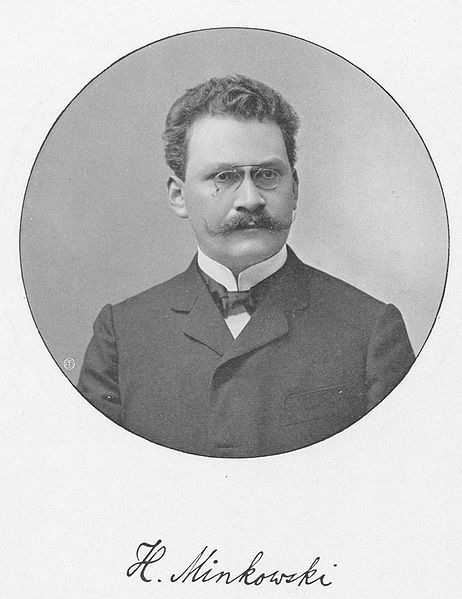
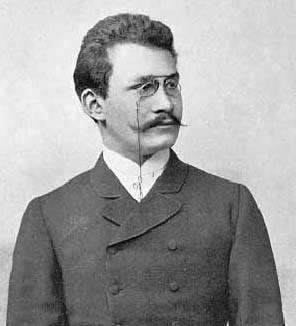
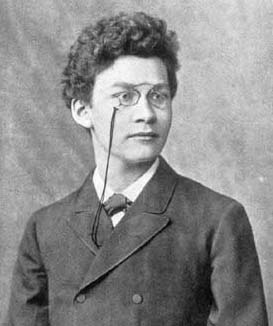
Hermann Minkowski (June 22, 1864 – January 12, 1909) was a mathematician. He created and developed the geometry of numbers and used geometrical methods to solve difficult problems in number theory, mathematical physics, and the theory of relativity.
Hermann Minkowski was born in Aleksotas, a suburb of Kaunas, Lithuania (then occupied by the Russian Empire) to a family of Lithuanian Jews. Minkowski later converted to Christianity, in order to pursue his academic career. Hermann was educated in Germany at the Albertina University of Königsberg, where he achieved his doctorate in 1885 under direction of Ferdinand von Lindemann. While still a student at Königsberg, in 1883 he was awarded the Mathematics Prize of the French Academy of Sciences for his manuscript on the theory of quadratic forms. He also became a friend of another German mathematician, David Hilbert. His brother, Oskar Minkowski (1858 – 1931), was a well known physician and researcher.
Minkowski taught at the universities of Bonn, Göttingen, Königsberg and Zürich. At the Eidgenössische Polytechnikum, today the ETH Zurich, he was one of Einstein's teachers.
Minkowski explored the arithmetic of quadratic forms, especially concerning n variables, and his research into that topic led him to consider certain geometric properties in a space of n dimensions. In 1896, he presented his geometry of numbers, a geometrical method that solved problems in number theory.
In 1902, he joined the Mathematics Department of Göttingen and became one of the close colleagues of David Hilbert, whom he first met in Königsberg. Constantin Carathéodory was one of his students there.
Minkowski died suddenly of appendicitis in Göttingen in 1909.
By 1907 Minkowski realized that the special theory of relativity, introduced by Albert Einstein in 1905 and based on previous work of Lorentz and Poincaré, could be best understood in a four dimensional space, since known as "Minkowski spacetime", in which time and space are not separated entities but intermingled in a four dimensional space - time, and in which the Lorentz geometry of special relativity can be nicely represented. The beginning part of his address delivered at the 80th Assembly of German Natural Scientists and Physicians (September 21, 1908) is now famous:
"The views of space and time which I wish to lay before you have sprung from the soil of experimental physics, and therein lies their strength. They are radical. Henceforth space by itself, and time by itself, are doomed to fade away into mere shadows, and only a kind of union of the two will preserve an independent reality."
David Hilbert's obituary of Minkowski illustrates the deep friendship between the two mathematicians:
- Seit meiner Studienzeit war mir Minkowski der beste und zuverlässigste Freund, der an mir hing mit der ganzen ihm eigenen Tiefe und Treue. Unsere Wissenschaft, die uns das liebste war, hatte uns zusammengeführt; sie erschien uns wie ein blühender Garten. Gern suchten wir dort auch verborgene Pfade auf und entdeckten manche neue, uns schön dünkende Aussicht, und wenn der eine dem andern sie zeigte und wir sie gemeinsam bewunderten, war unsere Freude vollkommen. Er war mir ein Geschenk des Himmels, wie es nur selten jemand zuteil wird, und ich muss dankbar sein, dass ich es so lange besaß. Jäh hat ihn der Tod von unserer Seite gerissen. Was uns aber der Tod nicht nehmen kann, das ist sein edles Bild in unserem Herzen und das Bewusstsein, dass sein Geist in uns fortwirkt.
- Translated:
- Since my student years Minkowski was my best, most dependable friend who supported me with all the depth and loyalty that was so characteristic of him. Our science, which we loved above all else, brought us together; it seemed to us a garden full of flowers. In it, we enjoyed looking for hidden pathways and discovered many a new perspective that appealed to our sense of beauty, and when one of us showed it to the other and we marveled over it together, our joy was complete. He was for me a rare gift from heaven and I must be grateful to have possessed that gift for so long. Now death has suddenly torn him from our midst. However, what death cannot take away is his noble image in our hearts and the knowledge that his spirit in us continue to be active.
The asteroid 12493 Minkowski and M-matrices are named in his honor.